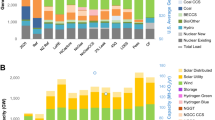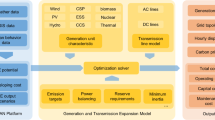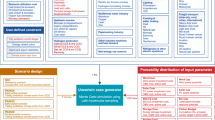Abstract
The reform of China’s electricity generation to move from a centrally planned operation (CPO) to a market-based system has progressed slowly over the past decade. The slow reform pace hindered the market-share reallocation over power plants with divergent carbon intensity and thus locked the carbon trajectory of China’s power sector. Here we analyse the effects of the delayed electricity market reform in terms of CO2 emissions. Constrained by a sequence of unique fairness regulations, a multi-timescale dispatch model is developed to quantify the CPO-induced CO2 emissions from China’s power sector. We find that continuing to generate electricity through the CPO has produced an additional 3 GtCO2 emissions over 2011–2019, an amount equivalent to the total emissions of India, which is the world’s fourth-largest carbon emitter. In some provinces, the level of extra emissions accounts for up to 20% of the annual power-related greenhouse gas (GHG) emissions. We find that national level GHG emissions have increased because the CPO over-allocated ~30% of the market shares of electricity generation to high-carbon power plants, including those in provinces that have been implementing energy-saving operation policies. In addition, we find the China’s growing investment in generation capacity has exacerbated the GHG emissions impact of the CPO, whereas China’s investment in fuel efficiency improvement has reduced CPO-related emissions by over 13%. Our discoveries manifest that the economic institution and its transition in the energy sector can substantially impact the GHG trajectory and thus play a critical role of the sustainability of human society.
This is a preview of subscription content, access via your institution
Access options
Access Nature and 54 other Nature Portfolio journals
Get Nature+, our best-value online-access subscription
$29.99 / 30 days
cancel any time
Subscribe to this journal
Receive 12 digital issues and online access to articles
$119.00 per year
only $9.92 per issue
Buy this article
- Purchase on Springer Link
- Instant access to full article PDF
Prices may be subject to local taxes which are calculated during checkout




Similar content being viewed by others
Data availability
The data that support the plots within this paper and other findings of this study are available as Source data.
Code availability
The code used in this study is available from the corresponding author upon request.
References
Mun, S. H., Wang, Z. & Yu, Z. China’s power generation dispatch (Resources for the Future, 2017); http://www.rff.org/files/document/file/RFF-Rpt-ChinaElectricity.pdf
Xia, Q., Chen, Y. & Chen, L. Establishment of mode and method for energy-conservation monthly unit commitment considering dispatching. Power Syst. Technol. 35, 27–33 (2011).
Regulations Improving the Electricity Dispatch’s Transparency, Fairness, and Equity (State Electricity Regulatory Commission, 2004); http://www.nea.gov.cn/2011-08/16/c_131052767.htm
Davidson, M. R. et al. Modelling the potential for wind energy integration on China’s coal-heavy electricity grid. Nat. Energy 1, 16086 (2016).
Liu, L., Zong, H., Zhao, E., Chen, C. & Wang, J. Can China realize its carbon emission reduction goal in 2020: from the perspective of thermal power development. Appl. Energy 124, 199–212 (2014).
Wang, J. et al. Exploring the trade-offs between electric heating policy and carbon mitigation in China. Nat. Commun. 11, 6054 (2020).
Code for Implementing the Energy Saving Dispatch Policy (National Development and Reform Commission of P.R.C., 2011); http://www.nea.gov.cn/2011-11/22/c_131262571.htm
Zhang, Z. Are China’s climate commitments in a post-Paris agreement sufficiently ambitious? Wiley Interdiscip. Rev. Clim. Change 8, e443 (2017).
Liu, Z. China’s Carbon Emissions Report 2016 (Harvard Kennedy School, Belfer Center for Science and International Affairs, 2016).
Zhong, H., Xia, Q., Chen, Y. & Kang, C. Energy-saving generation dispatch toward a sustainable electric power industry in China. Energy Policy 83, 14–25 (2015).
Kahrl, F., Williams, J. H. & Hu, J. The political economy of electricity dispatch reform in China. Energy Policy 53, 361–369 (2013).
Ciwei, G. & Yang, L. Evolution of China’s power dispatch principle and the new energy saving power dispatch policy. Energy Policy 38, 7346–7357 (2010).
Ou, X., Yan, X. & Zhang, X. Life-cycle energy consumption and greenhouse gas emissions for electricity generation and supply in China. Appl. Energy 88, 289–297 (2011).
Ding, Y. & Yang, H. Promoting energy-saving and environmentally friendly generation dispatching model in China: phase development and case studies. Energy Policy 57, 109–118 (2013).
Wei, Y. M. et al. Economic dispatch savings in the coal-fired power sector: an empirical study of China. Energy Econ. 74, 330–342 (2018).
He, G. et al. Rapid cost decrease of renewables and storage accelerates the decarbonization of China’s power system. Nat. Commun. 11, 2486 (2020).
Electricity Law of the People’s Republic of China (Standing Committee of the National People’s Congress, 2018); http://www.chinapower.com.cn/focus/20190222/1266992.html
Electricity Sector Regulation Ordinance (State Council of P.R.C., 2005); http://www.nea.gov.cn/2017-11/02/c_136723017.htm
Electricity Dispatch Rule in Guangdong (Guangdong Power Grid Corporation, 2012).
2017 Guangdong Power System Generation Dispatching Principles (Trial) (Guangdong Power Grid Corporation, 2017).
The Implementation of the Regulations on Power Grid Dispatch (National Energy Administration, 2012); http://www.nea.gov.cn/2012-01/04/c_131262769.htm
Hunan Provincial Grid Annual Power Generation Plan Preparation Management Methods (Hunan Provincial Department of Industry and Information Technology, 2013); http://www.hunan.gov.cn/xxgk/wjk/szbm/szfzcbm_19689/sjjhxxhwyh_19708/gfxwj_19709/201305/t20130505_4885452.html
Shanghai Annual Power Generation Plan Management Measures (Shanghai Power Grid Corporation, 2011).
James, B., Alejandro, I. Y. & Nicholas, P. Electricity transmission cost allocation and network efficiency: implications for Mexico’s liberalized power market. Util. Policy 59, 100932 (2019).
Elis, N. & Lennart, S. An open dispatch model for the Nordic power system. Energy Strategy Rev. 39, 100775 (2022).
Liu, M., Ronald, S. & Bing, Z. Does environmental regulation affect labor demand in China? Evidence from the textile printing and dyeing industry. J. Environ. Econ. Manag. 86, 277–294 (2017).
The Coal-Price Index (Fenwei Energy Information Service Company Limited, 2017); http://www.sxcoal.com/price/index
Daily Natural-Gas Reports (Energy Cngold Org, 2021); https://www.cngold.org/tianranqi/
China Electricity Statistical Yearbook (China Electricity Council, 2011–2020).
Compilation of Statistical Information on the Electric Power Industry (China Electricity Council, 2014).
Hoag, H. Low-carbon electricity for 2030. Nat. Clim. Change 1, 233–235 (2011).
Chai, Q. & Zhang, X. Technologies and policies for the transition to a sustainable energy system in China. Energy 35, 3995–4002 (2010).
Chen, Q., Kang, C., Xia, Q. & Guan, D. Preliminary exploration on low-carbon technology roadmap of China’s power sector. Energy 36, 1500–1512 (2011).
National Coal Power Unit Renovation and Upgrading Implementation Plan (National Development and Reform Commission of P.R.C. and National Energy Administration of P.R.C., 2021); https://www.ndrc.gov.cn/xxgk/zcfb/tz/202111/t20211103_1302856.html?code=&state=123
Cui, R. Y. et al. A plant-by-plant strategy for high-ambition coal power phaseout in China. Nat. Commun. 12, 1468 (2021).
Peng, W. et al. Managing China’s coal power plants to address multiple environmental objectives. Nat. Sustain. 1, 693–701 (2018).
Principles on Further Reforming the Electricity Sector (Document No. 9 of CPC Central Committee) (Central Committee of China’s Communist Party and the State Council of P.R.C., 2015).
Wang, K. et al. Emissions trading and abatement cost savings: an estimation of China’s thermal power industry. Renew. Sustain. Energy Rev. 65, 1005–1017 (2016).
Yu, Y. & Rajagopal, R. The impacts of electricity dispatch protocols on the emission reductions due to wind power and carbon tax. Environ. Sci. Technol. 49, 2568–2576 (2015).
National Development and Reform Commission on strengthening and improving Guidance on the management of power generation operation and regulation (National Development and Reform Commission of P.R.C., 2014); https://www.ndrc.gov.cn/fzggw/jgsj/yxj/sjdt/201405/t20140522_987606_ext.html
Principle on Incrementally Deregulating the Electricity Generation Quota Regulation (National Development and Reform Commission of P.R.C. and National Energy Administration of P.R.C., 2015); https://www.gov.cn/xinwen/2015-11/30/5018221/files/fc56705237344ad9912144cae1d10523.pdf
Principle on Developing the Market Mechanism for the Electricity Sector (National Development and Reform Commission of P.R.C. and National Energy Administration of P.R.C., 2015); https://www.gov.cn/xinwen/2015-11/30/5018221/files/87556b7e1f4f4aaab86ac7c99f5acf3f.pdf
Acknowledgements
We thank P. Zou for policy interpretation and interview design, and L. Chen for assistance on market simulation. We thank the National Natural Science Foundation of China no. 71921003, 72140005 and U1966204 for supporting B.Z., Y.Y. and J.W., respectively. We also acknowledge the support of the Institution for Interdisciplinary Information Core Technology, the Tsinghua University-China Three Gorges Corporation Joint Research Center for Climate Governance Mechanism and Green Low-Carbon Transformation Strategy, and the International Joint Mission on Climate Change and Carbon Neutrality.
Author information
Authors and Affiliations
Contributions
Y.Y., J.W., J.U. and B.Z. conceived and designed the research. Y.Y., J.W. and Q.C. developed the framework and formulated the theoretical model. Y.Y., J.U. and B.Z. wrote the introduction. Y.Y., J.W., Q.D. and S.L. carried out the data search. Y.Y., J.W., Q.C. and Q.D. carried out the simulations and analyses. All authors contributed to the discussions on the method and the writing of this article.
Corresponding author
Ethics declarations
Competing interests
The authors declare no competing interests.
Peer review
Peer review information
Nature Sustainability thanks Laurence Delina and the other, anonymous, reviewers for their contribution to the peer review of this work.
Additional information
Publisher’s note Springer Nature remains neutral with regard to jurisdictional claims in published maps and institutional affiliations.
Supplementary information
Supplementary Information
Supplementary Discussion, Supplementary Fig. 1 and Supplementary Tables 1–7.
Source data
Source Data Fig. 2
Statistical source data of changes in the CPO’s carbon impact, influence of carbon and market environments.
Source Data Fig. 3
Statistical source data of carbon impact, market environment and quota distributions.
Source Data Fig. 4
Statistical source data of carbon impacts of the two protocols and their interactions.
Rights and permissions
Springer Nature or its licensor (e.g. a society or other partner) holds exclusive rights to this article under a publishing agreement with the author(s) or other rightsholder(s); author self-archiving of the accepted manuscript version of this article is solely governed by the terms of such publishing agreement and applicable law.
About this article
Cite this article
Yu, Y., Wang, J., Chen, Q. et al. Decarbonization efforts hindered by China’s slow progress on electricity market reforms. Nat Sustain 6, 1006–1015 (2023). https://doi.org/10.1038/s41893-023-01111-x
Received:
Accepted:
Published:
Issue Date:
DOI: https://doi.org/10.1038/s41893-023-01111-x



